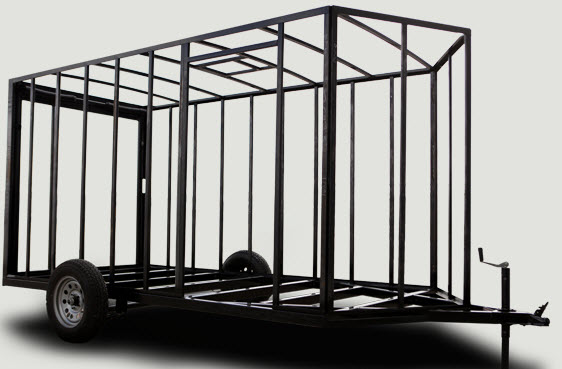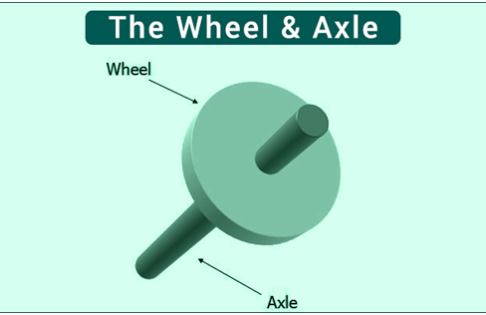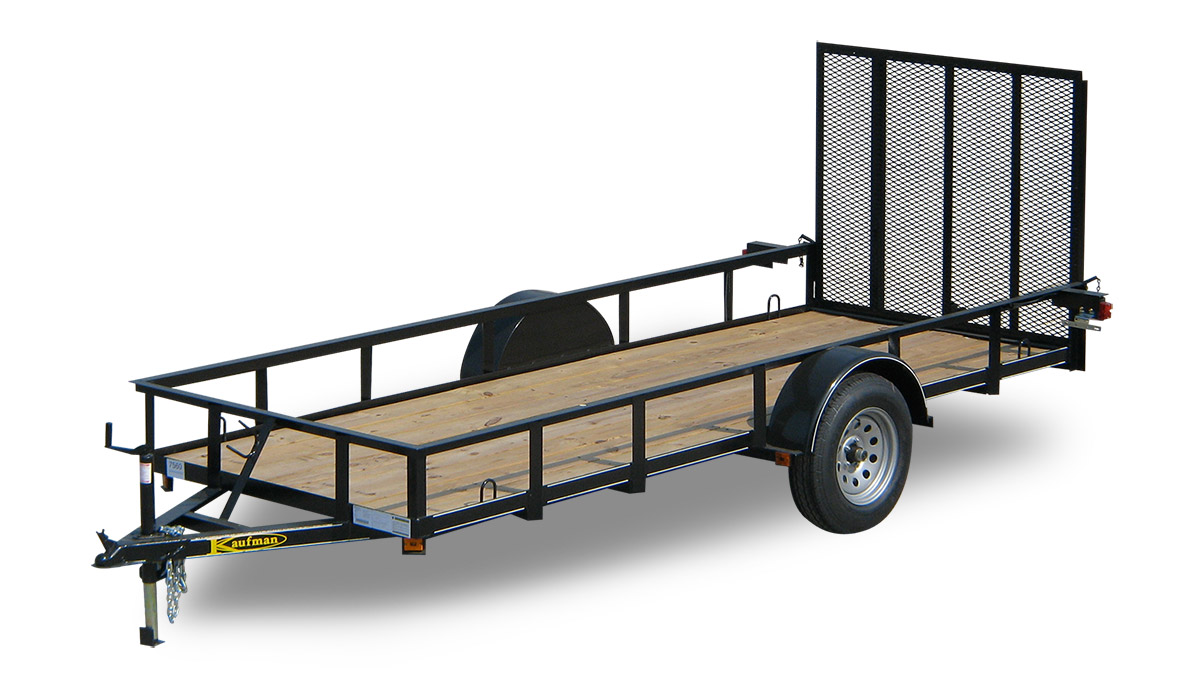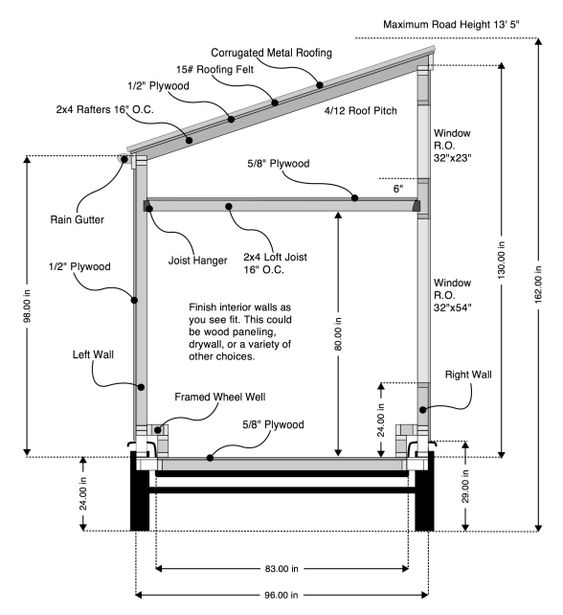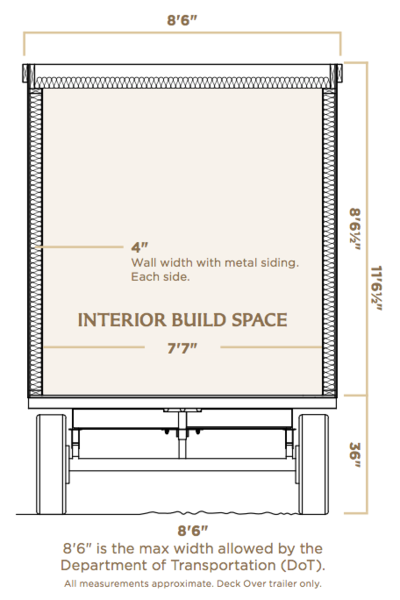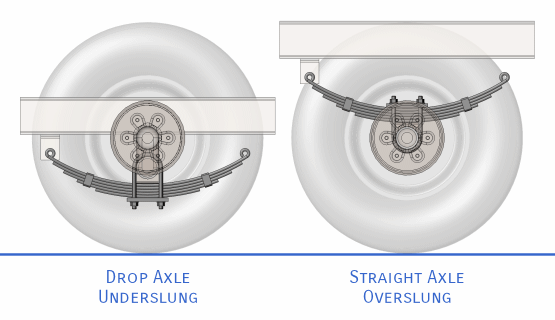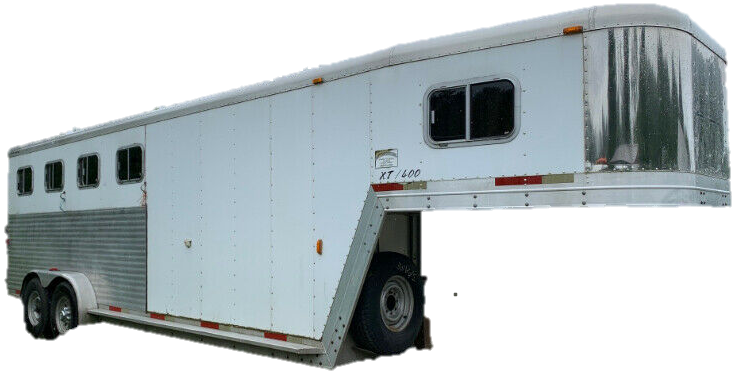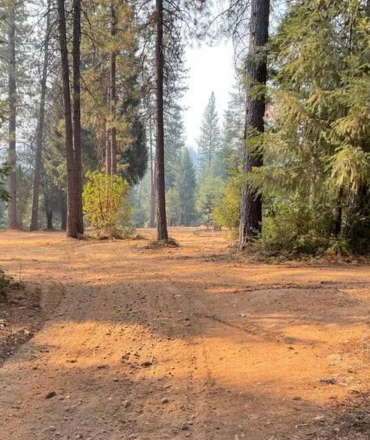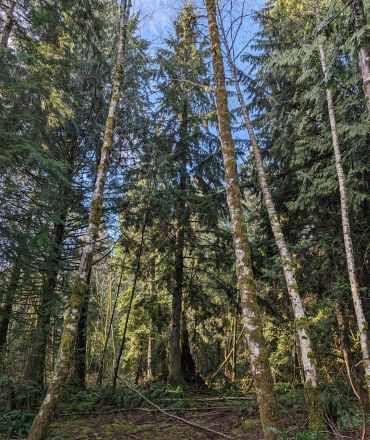Tiny House Trailers: Structure, Components and how to choose the Right One
While we were building on a tiny house specific trailer, we found that the build experience can be challenging and in this article I’d like to share with you how to properly build your tiny house on wheels (a trailer).
There are different styles of trailers – let’s start be exploring the various types of trailers – their components, structure and how they can be used to build your tiny house.
Lets start with the basics
Axels
An axle is a central shaft for a rotating wheel or gear. On wheeled vehicles, the axle may be fixed to the wheels, rotating with them, or fixed to the vehicle, with the wheels rotating around the axle. These are the horizontal round pieces of metal that the wheels are attached to, and there are a lot of different arrangements to have on a trailer. It allows us to go from a single-axle to double-axle or even to a triple-axle. Axels are rated for different capacities
Single-axle
Single-axle trailers just have one set of wheels and it is no more than 14 feet in length. Using anything longer than 14 feet, two axles is going to be required to carry that much weight. Single axle trailers are very maneuverable. It would be the best if needed to pull over tight spaces. Single-axle trailers are for much smaller houses and lighter house.
Double-axle trailer
The double-axle trailer which sometimes called a tandem axle trailer has two sets of wheels that are next to each other. Those remain somewhere kind of in the middle of the trailer. Double-axle trailer can go up to about 24 feet in length. It is seen that a tiny house is built on a 22 feet dual axle trailer while some people think that one shouldn\’t go more than 20 feet on a dual axle. It really depends on the weight rating of those axles. Though double-axle trailers have been really common in the tiny houses but as the tiny houses are getting a bit bigger, we are now seeing more uses of triple-axle trailers.
A triple-axle trailer has three sets of wheels and those can be really long. The length could be as long as 36 feet. Tiny houses built on triple-axle trailers, usually starts at about 24 feet-26 feet and goes up. The triple-axle trailers are less maneuverable than double-axle trailers, which are less maneuverable than single-axle trailers
When you get to…
Choosing the trailer
Gross Vehicle Weight Rating which is abbreviated as GVWR. The GVWR tells us about the load that the trailer is legally rated to carry, it is the maximum safe load that can be put on that trailer. To exceed the GVWR is against the law. If someone is caught violating the weight limit could be fined or not be allowed to move the tiny house. GVWR includes the weight of the trailer itself.
A trailer that is rated to carry 10,000 pounds, actually cannot carry 10,000 pounds of additional weight. It can carry the weight leaving out the trailer’s weight.
For a 10,000 pounds rated trailer, if the trailer itself weights about 1,400 pounds it could carry 8,600 pounds of additional weight by the law. Axles are stamped with a GVWR rating, it is usually 3,500-5,000 pounds or 7,000-10,000pounds. If we do the math, it would be possible to have a trailer that could carry 14,000 pounds with two 7,000 pounds GVWR rated axles or three 5,000 pounds axles. If your need to build a tiny house with a trailer that could tow 20,000 pounds, it could be done with 2 x 10,000 pounds axles or 3 x 7,000 pounds axles. It should be kept in mind that triple-axle trailer with three 5,000 pounds axles will be cheaper than two 7,000 pounds axles.
Wheel and fenders
Fenders are the things that cover the wheels. There are fenders that extend above the body of the trailer and have the wheel wells underneath them. The wheel wells generally mean the maximum width of that trailer, so the outside edges of those fenders are typically extended to the maximum legal width of 8 feet 6 inches which is for the United States. It varies but for most states the maximum width is 8 feet 6 inches. On a standard straight beam, axle trailer, the fenders are going to be about 9 to 10 inches above the deck.
There are some tiny house designs that are designed to go in between the wheel wells. So, for example, a tiny house could be built in between the wheel wells rather than allowing the wheel wells to protrude into the space. Now a days it common to see wheel wells sticking to the house. People often try to hide the wheel well, sometimes the wheel well is made into the first stair of the house again sometimes its hidden under a couch or a cabinet. Wheel wells is important and it\’s an option on trailers. A great change has been seen by the companies which manufacture tiny house trailers to make the wheel wells squared rather than round which makes it much easier to frame walls around them, creating a template out of cardboard an angle rather than a curve. A new trailer will likely be the single most expensive item in our entire tiny house. If a tiny house is on wheels, then the trailer is the foundation of the house. Hence it is recommended to use new trailers. Used trailers cannot always be verified. We cannot be sure about an old trailer, if there is a damage or how long that has been used. Replacing other parts of the house is much easier, if there is any problem with the roof that could be changed; the trailer remains intricately attached with the house as a result changing it would be a big issue. Since 2013 tiny house trailers have come a really long way. There are tiny house specific trailers with things like square wheel wells.
Tiny house trailers versus utility trailers
Custom trailers came from D. Williams book Go House Go and he suggested working with a trailer manufacturer to custom build a trailer to allow the sub floor of our tiny house to attach inside of the trailer frame rather than on top of it, this was the scenario back in 2012. A lot of these tiny house specific trailers were designed so that the floor could be set into the trailer frame rather than on top of it which allows both to lower the floor of the tiny house and therefore give more height. Other than that, it also allows to get more insulation in the floor of your tiny house. If you make the floor lower, you can keep the peak of the roof at the same maximum height, and you get those extra few inches of gain inside of the house. Another great thing about tiny house trailers is some of them come with a welded metal belly pan basically on the underside of the trailer framing the manufacturer welds on sheet metal, and so the trailer is closed off from the bottom which saves a lot of time in during the build. We don’t have to deal with plywood or covering up the underside of the trailer just by laying floor Joyce into the trailer, insulating between them and to put a sub floor decking right on top. The belly pan’s really do save time.
Drop Axels
First of all both standard and dropped axle trailers are usually 20 foot X 99 – 102 inch wide on 10,000 gross capacity.
Drop axles are another technology that have become popular in tiny house building. Drop axles are yet another way to lower your tiny house closer to the road so that It can make the house itself more spacious, taller. On a standard straight beam axles, the deck height is about 26 inches off the ground, and then with drop axles, it’s lower (usually 4 inches).
We need to be careful with lowering the trailer because that does reduce clearance, and it can be problematic for longer houses bottoming out when pulling into steep driveways or down steep inclines. The way drop axles are shaped it is not a straight line rather like the letter U. Those make the trailer deck a bit narrower between the wheel wells, and the narrower width doesn\’t mean you\’ll sacrifice on the overall width of the house. But this will have part of the house hanging out over the edge of the trailer. Those parts may not have as much insulation as the parts that are over the trailer deck. Another innovation to be used in the tiny house trailer space is called deck over trailers. Building a tiny house around the wheel wells of a trailer is one of the most difficult parts of the build, particularly it is important to prevent water from infiltrating your home behind those wheel wells, and people come up with a number of solutions in order to do that. To not deal with the wheel well at all would be a deck over trailer where the trailer deck is actually on top of the wheels. The big downside to the deck over trailer is that it\’s higher off the ground. It\’s about three feet off the ground, and that\’s going to take away from the height of the tiny house but not having to deal with wheel wells is a big benefit to consider.
The height of drop axel trailer is just about 21 inches. They seem to range about 21 to about 22 inches for drop axles on most tiny-house trailers. This one is pretty much identical to standard hight trailers. When you we will be building a tiny house shell on a trailer you should choose 99 inches wide. This way when you finish exterior and siding is placed on the trim, the full house will be a full 102 inches wide or eight and a half feet wide.
Four to five inch difference may not seem like a lot, but it is when it comes to building the tiny house. When the trailer is lower the entry into the tiny house is a lot easier. It’s just easy to step up into the house and then, the standard trailer, definitely is on a much higher level and requires more effort to step into it. Also it\’s quite important that you will gain about four or five inches headroom. So, there are some benefits to get the drop axles on your tiny house trailer. Usually the price runs 125 dollars per axle. So It’s usually about 250 dollars extra.
Gooseneck Trailers
Gooseneck Trailers are becoming more common for moveable, tiny homes because they allow the weight of the tiny house to be more evenly distributed onto the tow vehicle. A goose neck actually has a raised portion that kind of sits above the truck. This actually pulls the whole trailer in closer to the tow vehicle, a 28 feet goose neck will toe more like a 24 feet trailer because a lot of the house is hanging above the trailer in this way. Goose neck trailers are sometimes referred to as fifth wheel trailers those connect to a hitch in the bed of the truck rather than at the bumper. Another plus is that the raised goose neck portion of the trailer is able to be built on so builders may put bedroom or an office in that space. Since the overall interior height of the home in that section is going to be a lot smaller, the space below the goose neck can be used for storage.
Tiny homes are a bit more specialized, finding a vehicle that is outfitted with the proper hitch, it’s much less likely to find a truck that has the goose neck hitch. Most trucks have a bumper hitch for pulling a bumper hole. Prevalence of the goose neck hitches are much lower.
Building materials
Different types of steel that a trailer can be made out of
There are three kinds of framing. L channel C channel and Tube framing. L channel is very commonly used and it is shaped like an L, it is the weakest of options. It is suggested that L channel trailers are not up to the task of towing a tiny house on wheels and more sturdy framing material such as C channel or tube framing should be sought. C channel is shaped like the letter C. It\’s not as strong as tube framing, but it\’s definitely stronger than L channel. At last the tube framing is on the high end, its shaped like a rectangle even though it\’s called tube framing. It’s definitely the strongest of the three. The really high-end trailers are typically made completely out of tube framing or at least the perimeter of them is made from tube framing. So, it could be said L channels are good, C channel is better and tube framing is the best.
People often do not think about the material of which the trailer is made of, as mostly it is made of steel. However, some trailer manufacturers have begun to offer aluminum tiny house trailers and aluminum trailers have a number of benefits compared to the steel counterparts. Those are 1000-2000 pounds lighter than steel trailers that enables to put more weight into the house, having to account for a heavier trailer. Aluminum is also much more resistant to corrosion it will not rust like a steel trailer especially if it gets scratched or dented. The downside to aluminum is the cost. There\’s a company called Tiny Houses of Maine. They sell 8 feet by 20 feet, 12,000 GVWR drop axle aluminum trailer for about $7000, a comparable steel trailer could be purchased for between four and $5000. There is a bit of a cost savings using steel over aluminum but the trade is weight for cost.
Accessories
There are a lot of different accessories that a trailer could come with. There are some accessories which are absolutely must like breaks. Tiny houses are so heavy that the trailers need to have their own braking system. We can\’t rely on the brakes of the tow vehicle, so all trailers should come with brakes. Another thing that all trailer should come with is lights brake lights, turn signals & side markers. It will be illegal to tow your trailer without lights. The other thing that it should come with is emergency chains. This prevents the trailer from becoming a runaway, if anything goes wrong with the tow vehicle. It should also have an emergency braking system which is a chord that gets pulled. There should a jack that allows to lift the hitch end of the trailer up and down, back the tow vehicle in and then lowered back down onto the hitch.
There are some accessories that utility trailers typically come with. Any ramps for a trailer are certainly not needed. Some standard utility trailers come with an accessory called a Dovetail, this is kind of the back end of the trailer bed which makes it turn. It’s angled downwards that makes it easier to pull cars up onto the trailer. But it would make it really challenging to build a tiny house on, definitely dovetail is not recommended at all. There are steak pockets on some trailers that just allows to try to attach a temporary almost fence to the trailer. pieces of wood could be put down into the steak pockets but again it is not needed. Front rail is found on some utility trailers at the tongue end of the trailer. Usually people do not keep those in their tiny house trail, they end up cutting it off with an angle grinder.
Optional Accessories
There are two different kinds of jacks. A set of four jacks, one placed at each corner of the trailer that allows to very quickly and easily level your tiny house is known as Levelling Jacks. It is highly recommended. Those can be added to our trailer. Usually it’s a custom addition, can be added later. But it is suggested to have them added at the time of buying the trailer. The other which is not recommended is Scissor Jacks. These are very typical like the spare tire in our car. It’s kind of shaped like a triangle, might say shaped like a diamond with a screw running across. Most scissor jacks have a weight capacity much lower than the overall weight of the house. It is recommended skipping the scissor jacks completely and going with a similar jack that would be found on the tongue of the trailer. A jack that is a more of a vertical styled jack, and those are designed to lift much more weight.
